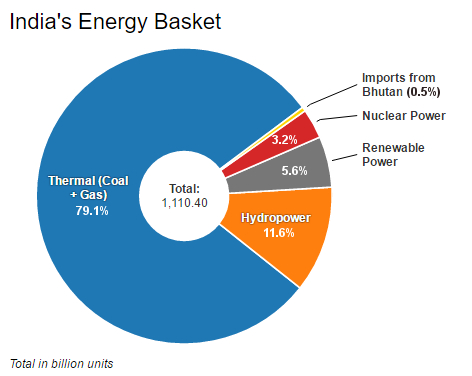Cheaper Renewable Energy Soars Past Nuclear Power In India
Renewable energy in India has overtaken nuclear power as the country seeks carbon-free sources of energy to balance its reliance on coal. It accounts for 5.6% of electricity generated in India, against 3.2% for nuclear power.

Renewable energy in India has overtaken nuclear power as the country seeks carbon-free sources of energy to balance its reliance on coal.

Renewable-energy generation in India is higher than its nuclear-power generation and is growing at a much faster pace because it is cheaper and quicker to install. The cost of renewable energy is now lower than the cost of nuclear power and does not come with attendant risks, such as this week’s radioactive fuel leak in Gujarat.
Renewable-energy generation in India was 61.8 billion units, versus 36.1 billion units of nuclear-power generation during the financial year (FY) 2014-15. Renewable energy accounted for 5.6% of electricity generated in India, against 3.2% for nuclear power.

Renewable energy has been growing at a faster pace than nuclear power over two years.
During 2013-14 and 2014-15, renewable energy grew at 11.7% and 16.2%, respectively, while nuclear-power growth has been almost flat over the same period.
If 2022 solar target is met, it will become India’s second-largest energy source
The bulk of India’s renewable energy comes from wind , but solar energy is growing faster, with installed capacity reaching 5,775 mega watts (MW) in February 2016. The national solar mission has set a target of 100,000 MW of solar power by 2022. If this target is met, renewable energy will become the second-largest source of power for India, after coal, and ahead of hydropower, natural gas and nuclear energy.
Nuclear-power capacity in India is 5,780 MW; another 1,500 MW is under construction and another 3,400 MW has been cleared—a total of 10,680 MW by the end of the decade.
Renewable energy’s growth is propelled by the falling costs of solar and wind energy, as IndiaSpend reported.
In November 2015, US based SunEdison offered solar electricity in India at Rs 4.63/unit. In January 2016, this was followed by a Finnish company, Fortum Finnsurya, offering solar power to the National Thermal Power Corporation (NTPC) for Rs 4.34/unit.
At these prices, solar electricity is already cheaper than electricity coming from newly built hydro- and nuclear-power plants. For instance, India is now starting work on a Rs 39,849-crore expansion (2 units of 1,000 MW each) of the Kudankulam Nuclear Power Plant, Tamil Nadu, due to be completed by 2020-21. Electricity from these reactors—if they are completed on time—will cost Rs 6.3/unit.
Past experience in India and elsewhere suggests this is unlikely.
The slow progress of nuclear power—in India and worldwide
Work on Units 1 and 2 of the Kudankulam Power Plant began in 2001 and was supposed to be completed by 2007 and 2008. Unit 1 began commercial operations in December 2014 while Unit 2 is yet to be commissioned.
This experience is mirrored in other countries: a power plant being built by the US firm Westinghouse is more than three years behind schedule; a French company, Areva, isbuilding a reactor in Finland, about nine years behind schedule. Both, Areva and Westinghouse, are among four foreign companies that want to build reactors for the Nuclear Power Corporation of India.
While nuclear power plants typically take more than a decade to build, solar farms and wind-mills can be erected in a few weeks to a few months, with capacities that range from 0.1 MW to 1,000 MW.
Also, nuclear power plants are owned and operated in India by one company, the Nuclear Power Corporation of India. Solar and wind-energy installation have been set up by private individuals, airports, banks, oil companies and educational institutions.
Apart from shutdowns—such as this and this in Kundakulam, and the one we referred to in Gujarat—making nuclear power more expensive, there is also the issue of nuclear liability: Who pays in case something goes wrong? Foreign companies want to build reactors in India, but don’t want to face resultant liabilities, as IndiaSpend reported.
Renewable energy has its own problems
The single biggest problem of renewable power is its intermittent nature. The sun does not always shine, and the wind does not always blow.
So, 1 MW of renewable energy generated 1.43 million units of electricity from April 2015 to January 2016. Over the same period, 1 MW of nuclear power generated 5.85 million units of electricity. A nuclear-power plant can operate round the clock and can supply electricity at night.
There is currently no cost-effective answer for supplying renewable energy round the clock.
An interim solution can be to use renewable energy when it is available, and turn to natural gas, a fuel much cleaner than coal, at other times. India has more than 24,000 MW of natural-gas-fired power plants—enough to supply almost 10% of current electricity demand—mostly idle due to lack of cheap fuel. The drop in international gas prices offers an opportunity to fire them up again, as IndiaSpend has reported.
Solar power also needs a lot of land. Putting up 1 MW of solar power requires 2 hectares of land. This means large-scale solar power plants should only be put up on land that has no value for agriculture or wildlife. This restricts large-scale solar power to the arid areas of Rajasthan, Gujarat, Himachal Pradesh and Ladakh. Small-scale rooftop solar plants can, however, be installed in cities.
(Bhandari is a media, research and finance professional. He holds a B-Tech from IIT-BHU and an MBA from IIM-Ahmedabad.)
Like this story? Or have something to share? Write to us: [email protected], or connect with us on Facebook and Twitter (@thebetterindia).
This story made me
- 97
- 121
- 89
- 167
Tell Us More
We bring stories straight from the heart of India, to inspire millions and create a wave of impact. Our positive movement is growing bigger everyday, and we would love for you to join it.
Please contribute whatever you can, every little penny helps our team in bringing you more stories that support dreams and spread hope.




















